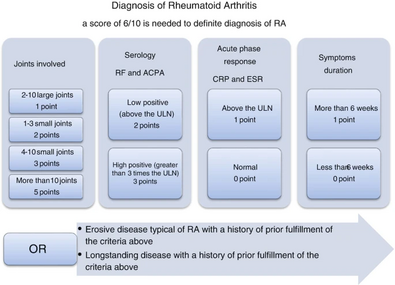Types of Rheumatic Disease
Original Editor - User Name
Top Contributors - Khloud Shreif, Lucinda hampton and Vidya Acharya
Introduction[edit | edit source]
Historically, "rheumatism" was a term used to describe a range of painful conditions affecting muscles, tendons, joints, and bones. Nowadays, we prefer the more precise term "rheumatic disease." Rheumatic disease RD is a comprehensive term encompassing arthritis and various other conditions, it encompasses over 200 different conditions, musculoskeletal system be the most affected system it is sometimes named musculoskeletal diseases, some of it's condition involving the immune system when mistakenly attacking the body's own tissues, which can lead to autoimmunity.
It is divided into:
- Autoimmune disease.
- Autoinflammatory disease.
- Degenerative/ metabolic disorders.
General Classification Criteria of Rheumatic Diseases[edit | edit source]
There is still no accurate solo diagnostic procedures to diagnose or confirm Rheumatic Diseases, the Classification criteria will help to distinguish between similar diseases and confirm or exclude a specific disease based on specific factors. These criteria are guidelines, not the only way to diagnose. Diagnosis of rheumatic disease can be challenging, it relies on clinical assessment, gathering a complete patient history and carefully evaluating the musculoskeletal system is very important, hence match the findings during clinical examination with lab, X-ray, and sometimes tissue samples to confirm the diagnosis[1].
Rheumatoid arthritis: In 1987, the American College of Rheumatology (ACR) introduced the initial classification criteria for RA, which required meeting 4 out of 7 criteria for over 6 weeks. Subsequently, a new classification criteria set was developed jointly by ACR/ EULAR in 2010. This updated criteria take in consideration the prognostic markers while maintaining high specificity and sensitivity. This allows for early patient identification and timely treatment with disease-modifying antirheumatic drugs DMARDs or inclusion in clinical trials for new therapies, enhancing care for those with early arthritis and enabling personalized treatment strategies.
| Autoimmune | Autoinflammatory | Degenerative/ metabolic disorders |
|---|---|---|
|
|
Vitamin D deficiency/osteomalacia
|
Rheumatoid Arthritis and Osteoarthritis[edit | edit source]
| Rheumatoid Arthritis | Osteoarthritis |
|---|---|
|
|
References[edit | edit source]
- ↑ Hassan R, Faruqui H, Alquraa R, Eissa A, Alshaiki F, Cheikh M. Classification criteria and clinical practice guidelines for rheumatic diseases. Skills in Rheumatology. 2021:521.







